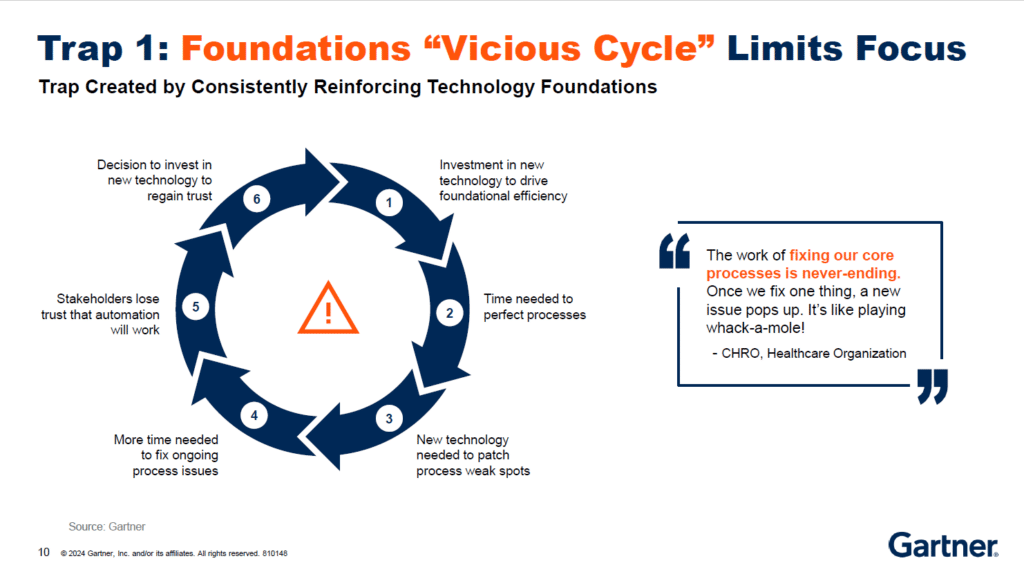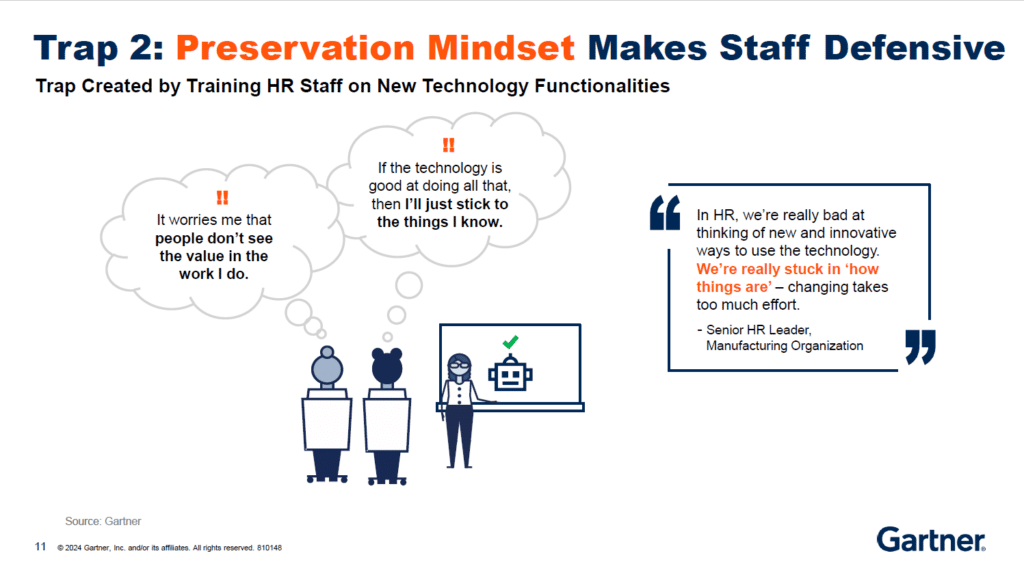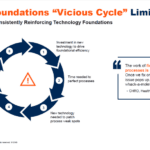One of the hottest selling points for HR tech adoption might be missing the mark, according to recent research. Many analysts have touted the benefits of AI and automation to increase HR’s capacity for strategic work, but fresh insights from Gartner reveal that relying only on this approach for AI adoption strategy can inadvertently restrict the business value of technology.
Shift from capacity focus to augmentation focus
A Gartner survey of 85 HR leaders conducted in February revealed that only 35% are confident their current approach to HR technology aligns with achieving business objectives. To increase confidence in this essential goal, Piers Hudson, senior director in the firm’s HR practice, highlights the importance of helping human resource leaders understand new tech’s ability to generate strategic business value.
This view adds a layer of insight to the common belief that HR technology will allow people to focus on the individual tasks they enjoy most, a vantage point that Hudson says does not inherently benefit the organization or the employee.
He says that plans to apply new technology should ensure employees are fully equipped to perform their jobs, not just eliminate tasks. “Part of the challenge here is that just freeing up HR staff’s time does not necessarily make them either skilled or confident in playing the different roles expected of them,” says Hudson.
Gartner’s research also highlights the organizational benefits of what they call an “augmented approach” to implementing HR tech. This perspective enhances HR by promoting the adoption of HR technology and leveraging it to generate high-impact contributions that maximize business value. The alternative is a “capacity-centric” approach, which emphasizes increased productivity or doing more with less.
There is more than a practical difference between the two processes—one delivers organizational advantages that can impact the bottom line. Gartner’s research suggests that the augmented method can increase the business value of HR technology by up to 54%. This is significantly higher than the 28% increase achieved with a capacity-centric approach.
HR acknowledges a tech impact gap
HR practitioners are aware that how they use new technology will impact their individual and departmental proficiency. Gartner’s research found that two out of three HR leaders believe their function’s effectiveness will diminish without improvements in their approach to technology, leaving a gap between current practices and future potential.
There may be several reasons for this. Technology has often automated tasks that HR professionals felt competent in, tasks that brought immediate positive feedback from their internal customers. This shift can increase the intensity of their roles, as they are left with more challenging or escalated responsibilities.
Also, many HR professionals value the relationship aspects of their job, such as providing support and coaching the workforce. Self-service technologies and automation can reduce these personal interactions, thus diminishing opportunities for these valued moments.
To bridge this gap, technology can help HR professionals by providing data to focus workplace efforts and identify underlying problems that might otherwise go unnoticed. However, this requires HR professionals to transition from having an “ear to the ground” through transactional work to leveraging data-driven insights, says Hudson.

Building blocks build confidence
Gartner’s research indicates that first introducing smaller technology changes can help secure buy-in for larger, more powerful technologies later. Hudson recommends creating technology plans or roadmaps that clearly show the connection between these smaller changes and the ultimate capabilities the organization aims to achieve. Breaking digital transformation projects into manageable segments can prevent HR leaders from feeling overwhelmed and disconnected from the workforce they serve.
For HR leaders aiming to present incremental plans rather than a large transformational goal, several strategies have proven effective, says Hudson. The Gartner team recommends using a building block framework, structured around increasing leadership confidence in technology transformation.

In this scenario, C-suite or other business leaders can sign off on segments that build toward the transformative goal. These segments should be fashioned around business goals. Gartner’s research reveals that focusing on “technology foundations” traps HR in a vicious cycle that undermines stakeholder confidence in HR’s ability to achieve transformational technology. Instead, as smaller goals are hit, leaders can see the business value of technology. If conditions change, adjusting building blocks is more manageable than retackling a massive transformational aim.
Ensuring that technology roadmaps visualize the link between smaller changes and the ultimate capabilities that HR hopes to provide is crucial. Hudson offers an example of a strategy that has proven successful for some Gartner clients: using coding to differentiate between basic and transformational initiatives and to distinguish between technology and process shifts.
Hudson says that code distinguishes initiatives and can help stakeholders see if these are indeed technology changes, or something else—for example, shifts to processes—so anyone can understand how segments fit into the HR tech roadmap. He provides an example: “If the ultimate goal is for HR to be better equipped to help drive productivity—and HR is supporting the implementation of a sophisticated ‘co-pilot’ type of technology to do this—what are all the smaller changes sitting underneath that ‘banner’?” says Hudson.
Another effective approach is to describe the ultimate end-state technology capability, often referred to as the 4.0 version. “Essentially, working back from the fully functioned, almost ‘imagined’ version,” according to Hudson. By breaking down the path to this advanced state into achievable milestones, he says, HR leaders can tell a compelling story and gain buy-in for initial changes. Demonstrating momentum with each incremental win helps accelerate progress toward the end goal.

HR’s preservation mindset
Hudson emphasizes that aligning business goals with HR technology is a key area for improvement that can significantly benefit the organization. Focusing on capacity as the primary means of deriving business value from HR technology underutilizes the technology and inadequately equips HR staff, says Hudson. He stresses the importance of using a technology roadmap process to engage stakeholders and determine the capabilities they expect HR to deliver.
Additionally, HR staff are often the closest to understanding the challenges business leaders have. However, they may feel threatened by technology and therefore not look for new use cases for the technology that could allow it to deliver much more value, Hudson says. Gartner calls this a “preservation mindset.”
Gartner found that capacity-focused HR tech investments may not move the organization forward, despite headlines touting productivity gains. Understanding what technology will remove from their roles makes HR staff protective of the areas where they currently add value. Training on how technology simplifies and improves current processes can reinforce the idea that existing methods are sufficient, strengthening the attachment to today’s workflows rather than boosting the organization toward next-level objectives.

Competing solutions create a dilemma for end users
Hudson cites one other roadblock that might slow the understating of the business value of HR technology. Because there is a tendency in HR functions to see the technology possibilities within the framework of the team’s corner of the department—recruiting, learning and development, benefits, etc.—human resources as a cohesive unit loses sight of the experience for the end user, who is usually a manager or an employee outside of the HR department.
Faced with HR solutions vying for their attention, managers struggle to know which HR lever to pull to achieve their outcomes, says Hudson. This isn’t good for the workforce or human resources, and nearly half of HR staff agree that HR technology solutions have damaged HR’s reputation across their organization, according to a 2024 Gartner study of over 600 practitioners.
Hudson advises HR practice leaders to create shared goals for the success of the overall HR technology portfolio. In some very complex areas, this may require the creation of roles targeted at coordinating technologies as “products,” says Hudson, with a greater focus on what the end user, rather than what HR, wants from using the technology.
Mark Whittle, vice president of advisory in the Gartner HR practice, says that while leaders believe that HR technology can be impactful, broadening their perspective beyond their own experience will deliver beyond workday efficiency. “The goal isn’t to maximize technology’s value to HR alone,” Whittle says, “but to maximize the business value the technology can bring to the entire organization.”
The post How a focus on productivity may limit HR tech’s true business value appeared first on HR Executive.



